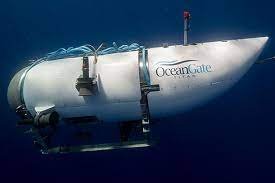The sinking of the RMS Titanic in 1912 was a tragedy that captured the world's attention. For over a century, the ship rested at the bottom of the Atlantic Ocean, its story becoming the stuff of legends. However, with advancements in technology, an ambitious project was undertaken to explore the depths and pay homage to the historic vessel. In this article, we will delve into the fascinating world of the Titanic submarine, the vessel that allows us to venture into the eerie depths where the mighty Titanic now lies.

Unveiling the Titanic Submarine:
In recent years, several organizations and private ventures have aimed to reach the Titanic's final resting place using advanced submersibles. The most notable of these is the Titanic Submarine, a specially designed vehicle built to withstand the immense pressures of the ocean depths. The submersible is equipped with state-of-the-art technology and serves as a means for scientists, historians, and explorers to document and study the iconic shipwreck.
Technical Specifications:
The Titanic Submarine is a robust and meticulously engineered vessel. It is constructed from strong and lightweight materials capable of withstanding the crushing pressures at great depths. The submarine's outer shell is composed of titanium, a metal known for its exceptional strength and resistance to corrosion. This allows the submersible to navigate the harsh conditions of the deep ocean.
The submersible is equipped with powerful thrusters that provide precise maneuverability, enabling it to explore the complex terrain of the wreck site. It also features a sophisticated robotic arm that can collect samples, take high-resolution images, and retrieve artifacts without disturbing the delicate ecosystem around the wreckage.
Exploring the Titanic Wreckage:
The primary purpose of the Titanic Submarine is to explore and document the remains of the Titanic. Equipped with high-definition cameras and powerful lights, the submersible captures stunning imagery that provides unparalleled insight into the ship's current state. By documenting the wreck, researchers can observe how the ship has deteriorated over time and study the effects of the deep-sea environment on its structure.
Beyond the visual documentation, the submarine is equipped with sensors and scientific instruments to gather data about the surrounding water, temperature, and marine life. This data helps scientists understand the ecological impact of the wreck and provides valuable information for ongoing conservation efforts.
#Preservation and Ethical Considerations:
Exploring the Titanic wreck comes with a great deal of responsibility. The organizations involved in these expeditions prioritize the preservation of the site and the respect for those who lost their lives. Strict protocols are in place to ensure that no further damage is inflicted upon the wreckage, and artifacts are recovered with care and sensitivity.
Additionally, the Titanic Submarine has been instrumental in mapping the debris field surrounding the shipwreck. This mapping aids in locating and preserving important artifacts and helps create a comprehensive picture of the events that unfolded during the Titanic's tragic demise.
Here's some additional information about the Titanic Submarine:
*Depth and Duration: The Titanic Submarine is designed to reach depths of up to 12,500 feet (3,800 meters). This depth is necessary to access the Titanic, which lies approximately 12,500 feet below the surface of the Atlantic Ocean. The submarine's advanced life support systems allow for extended dive durations, typically ranging from 8 to 12 hours, depending on the mission's objectives.
*Crew Capacity: The submarine is typically operated by a crew of three individuals—an experienced pilot, a co-pilot, and a mission specialist. These professionals work together to navigate the submersible, operate the robotic arm, manage the scientific instruments, and capture high-quality imagery and video footage.
*Scientific Research: The Titanic Submarine's expeditions go beyond simply documenting the wreckage. Scientific research conducted during these missions aims to enhance our understanding of marine biology, oceanography, and the impact of deep-sea environments on shipwrecks. Researchers study the unique microbial communities that thrive in the vicinity of the wreckage, investigate the corrosion and decay processes, and examine the effects of hydrostatic pressure on the ship's structure.
*Conservation Efforts: The exploration of the Titanic using the submarine has contributed significantly to conservation efforts. By understanding the changes that occur to the wreckage over time, researchers can develop strategies to mitigate any potential risks and preserve the site for future generations. This includes identifying areas where corrosion is accelerating and implementing protective measures to prevent further deterioration.
*Technological Advancements: The development of the Titanic Submarine has pushed the boundaries of deep-sea exploration technology. Lessons learned from designing and operating the submersible have led to advancements in underwater robotics, imaging systems, and materials engineering. These innovations have far-reaching applications, not only for deep-sea exploration but also for scientific research, underwater archaeology, and environmental monitoring in other parts of the world's oceans.
#Public Engagement and Education: The expeditions to the Titanic wreck using the submarine have captured the public's imagination and have been instrumental in raising awareness about maritime history, ocean conservation, and the importance of preserving underwater cultural heritage. Through documentaries, exhibitions, and educational programs, the experiences and discoveries made by the submarine's crew are shared with audiences around the world, inspiring a deeper appreciation for our oceans and the stories they hold.
The Titanic Submarine represents a remarkable blend of cutting-edge technology, scientific exploration, and historical preservation. As our understanding of the deep sea continues to evolve, this remarkable vehicle will likely play a pivotal role in uncovering new insights and preserving the legacy of the RMS Titanic for generations to come